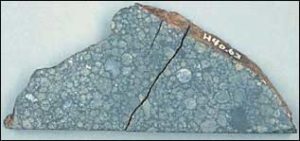Just before 4 a.m. on June 2, Arizona’s night sky seemed to momentarily catch fire. A meteor, about 5-feet across, burned through the atmosphere at 40,200 mph, according to NASA estimates. The small debris that reached the Earth’s surface are called meteorites, and can be used to study the origins of the solar system.
http://https://youtu.be/obCldOLFJZ8
Meteorites can be made out of iron, stone or rarely, both. Scientists at Project EOS are most interested in a subclass of stony meteorites called chondrites, because they congealed during the formation of the solar system and have been left virtually unchanged ever since. They are, in essence, time capsules from more than 4.5 billion years ago possibly carrying the starting materials from the early solar system to Earth, according to Maitrayee Bose, PhD., assistant research professor in the School of Molecular Sciences at Arizona State University and member of EOS.
“What we’re doing in this part of the project [EOS] is we are trying to understand the organic inventory of the early solar system and to do that, we’re studying organic compounds in meteorites,” said Tom Zega, PhD., associate professor in the Lunar and Planetary Laboratory at the University of Arizona.
Of the different kinds of chondrites, those called carbonaceous chondrites are the most interesting for EOS scientists, because they contain relic materials from the early solar system. The materials remained virtually unchanged prior to being delivered to Earth and contain ingredients for life in the form of organic compounds.
“The finding of compounds that are also part of the biosphere, such as amino acids… has led to hypotheses that the input of these compounds might have helped the origins of terrestrial life, and maybe could do so in other stellar systems,” said Sandra Pizzarello, PhD., emeritus professor and research professor in the School of Molecular Sciences at Arizona State University.
Opening the time capsule
Meteorites provide many clues about the past. Scientists can determine what a meteorite is composed of, the concentration of elements within the meteorite and where the grains from within the meteorite originated. So how is this done?
First, Bose receives a sample of a meteorite in her lab from Johnson Space Center. The sample is only tens of micrometers thick—less than half the width of a human hair. She surveys the meteorite’s surface using a secondary ion mass spectrometer capable of measuring at the nano-scale (NanoSIMS). This tool allows her to map the meteorite for carbon, hydrogen and nitrogen isotopes within the sample and determine the ratios of each isotope. Isotopes are different forms of the same kind of element which contain an equal number of protons but a different number of neutrons.

Maitrayee Bose poses for a photograph with the NanoSIMS 50L in the Physical Sciences Building D on Tempe campus (Arizona State University) on November 17, 2015. (Image credit ASU Now)
The mapping reveals tiny, less than 1 micrometer-sized locations in the meteorite whose isotopic compositions can differ throughout the meteorite as a whole. The meteorite’s composition can then be compared against the isotopic composition measurements taken from other meteorites within our solar system and also with astronomical structures outside of our solar system including material in the interstellar medium (ISM), stellar nebulae, ancient stars or dust shells around other stars using radio telescopes. From this information, Bose can confirm the meteorite’s origin.
Zega then takes the sample and focuses on an area of interest, such as an area with an isotopic composition suggesting extra solar origins. He uses a focused ion beam scanning electron microscope, or FIB, to make a cross section, and then uses a transmission electron microscope to investigate the atomic and molecular structure within the meteorite. Knowing how the atoms are arranged in space can tell him about the functional properties of the material or how the different atoms are bound to each other.
To hear an audio interview with Tome Zega about what meteorites can tell us about the origins of the ingredients for life, listen below:
Biocritical ingredients
Besides amino acids, “There’s a whole host of other organic compounds that occur in meteorites that are probably also a part of the building blocks [of life], or biocritical ingredients,” Zega said.
Phosphorus for example is an essential component of DNA. But scientists are still uncovering how this element was delivered to our own solar system, if it occurs in molecular clouds in space and if it chemically reacts in those clouds.
Water is another biocritical ingredient scientists are trying to learn the history of. Astronomers can directly observe water vapor in some exoplanetary atmospheres, but are still unable to directly observe liquid water on exoplanetary surfaces. But scientists have evidence to suggest that it was present as water vapor while the solar system formed.
“We know that there are certain materials in meteorites that formed around ancient stars and we think, based on their thermodynamic properties, required water vapor in their stellar atmospheres,” Zega said.
Iron oxide compounds have been found, for example, inside of meteorites. Based on the isotopic composition, their origins have been traced back to ancient stars. Based on our understanding of the way these minerals form, water was required for it to oxidize, giving scientists indirect evidence that water was present.
What meteorites mean for exoplanets
“Ours is the only solar system that we can study in such detail,” Bose said. What we learn about our own solar system can build our understanding of the potentially habitable worlds astronomers continue to discover and perhaps trace the molecular origins of life.

